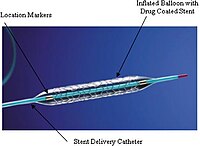
Photo from wikipedia
Aims Delayed healing and endothelial dysfunction may occur with drug-eluting stents (DES), promoting accelerated infiltration of lipids in the neointima and development of neoatherosclerosis (NA). Pathology data suggest durable polymer… Click to show full abstract
Aims Delayed healing and endothelial dysfunction may occur with drug-eluting stents (DES), promoting accelerated infiltration of lipids in the neointima and development of neoatherosclerosis (NA). Pathology data suggest durable polymer (DP) of DES to play a major role in this process. Whether biodegradable polymer (BP) may address these issues is uncertain. We compared in vivo vessel healing and NA of current generation BP- or DP-DES using serial optical coherence tomography (OCT) assessments. Methods and results Ninety patients with multivessel coronary artery disease were randomized 1:1 to BP everolimus-eluting stents (EES, Synergy) or DP zotarolimus-eluting stents (ZES, Resolute Integrity). Co-primary endpoints were the maximum length of uncovered struts at 3 months (powered for non-inferiority) and the percentage of patients presenting with frames of NA at 18 months (powered for superiority) as measured by OCT. The maximum length of uncovered struts at 3 months was 10 ± 8 mm in the BP-EES group and 11 ± 7 mm in the DP-ZES group (mean difference -1 mm; upper 97.5% confidence interval +2 mm; P = 0.05 for non-inferiority; P = 0.45 for superiority). The percentage of patients presenting with frames of NA at 18 months was low and similar between BP-EES and DP-ZES groups (11.6% vs. 15.9%; P = 0.56). There was no stent thrombosis in both groups at 24 months. Conclusion BP-EES and DP-ZES showed a similar healing response at 3 months and a low incidence of NA at 18 months. Biocompatible polymers, regardless of whether they are durable or biodegradable, may favourably impact the long-term vascular response to current-generation DES.
Journal Title: European Heart Journal
Year Published: 2018
Link to full text (if available)
Share on Social Media: Sign Up to like & get
recommendations!